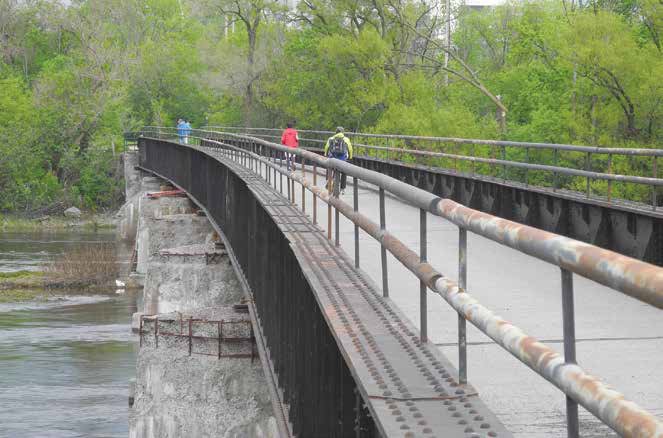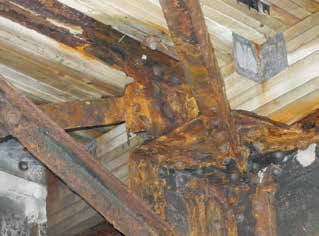
The old railway footbridge over the Ridea River could be replaced by a new footbridge just up stream from the current location. Photo by John Dance
John Dance
The old railway bridge that runs parallel to the Queensway and is currently a footbridge serving four wards may be demolished and replaced by a new bridge 100 metres to the south.
The news caught many community associations, heritage buffs and four City councillors off guard. However, keen interest by the various parties led to a recent meeting and the commitment that the affected communities will be invited to join an advisory committee to consider what may become of the old bridge and the planning of a replacement.
City staff explained that four years ago they’d conducted a “condition assessment and renewal scoping study” of the bridge. Local communities were unaware of this work. According to staff, the bridge is in an “advanced stage of deterioration.” However, it is inspected each year to ensure safety until the bridge is replaced.
Major structural deficiencies include severe corrosion of structural steel elements below the bridge’s deck and medium corrosion of steel elements above the deck. Further, there is the failure of the “steel coating system” and the “abutments and piers exhibit severe to very severe delamination and disintegration of the concrete encasement.” Originally built in 1898 as the Canadian Pacific Railway Rideau River Bridge, the bridge is Old Ottawa East’s oldest bridge and is the only remaining railway bridge of the three that used to cross the Rideau River from Old Ottawa East and Sandy Hill.

The steel support structure under the foobridge has corroded badly over the last few decades leading City staff to recommend its replacement. Photo by John Dace
CPR stopped using the bridge in 1966 and thirty years later the City acquired it, although during the intervening decades it became a key walking and cycling link. Over the years there has been considerable rehabilitation including concrete encasement of the masonry piers and abutments in 1952 and replacement of timber deck and wearing surface in 1999.
Local architect and heritage expert Barry Padolsky regularly visit the bridge and, in an article for the Sandy Hill Image, noted, “On my morning walks along the Rideau River, I discovered the fact that the bridge possesses an extraordinarily beautiful curve. I always assumed that it was straight. Yet when you squint along its axis, a most subtle curve is revealed, creating a visual liveliness that Ictinus and Callicrates, the architects of the Parthenon, well understood in 438 BC.”
When The Mainstreeter first contacted the City about the bridge, the City advised that it was in the process of procuring engineering design services and that construction was planned for 2024. In light of heritage and community interests, the schedule was revised to include an environmental assessment and consultation this year and next, with the detailed design beginning next year and finishing in 2023. Actual construction will tentatively be over the 2025-2026 period.
Depending on the heritage assessment, the new bridge would be constructed first and then the old bridge would be demolished so that pedestrians and cyclists would have continuous passage over the river.
Padolsky, who is a member of the City’s Built Heritage Sub-Committee has asked that the bridge be considered at the upcoming meeting of the sub-committee. He recommends that the City heritage staff undertake an assessment of the heritage value of the bridge with the objective of designating the structure under the Ontario Heritage Act “as a step towards preserving and rehabilitating this historic landmark.” He also is of the view that City staff should “evaluate the feasibility, relative costs and benefits of preserving and rehabilitating this historic landmark.”
“It seems that eventually, City staff will have erased any notion of the central role of the railways in Bytown’s and Ottawa’s development and any physical reminders to be among the key reasons why the City currently is structured the way it is,” notes Tom Scott, OOECA’s transportation director. “It’s heritage demolition by neglect.”
Preliminary recommendations for a new footbridge would result in a four-metre-wide deck – about twice as wide as that of the old railway bridge. Also, staff are suggesting a new bridge alignment would be better located if it were about 100 metres upstream of the existing bridge so that it would give “the most direct alignment for someone on the LRT pathway travelling over Riverside Drive to downtown.” The downside of such a realignment would be a detour for users who proceed along the Rideau River Eastern Pathway to and from Overbrook






